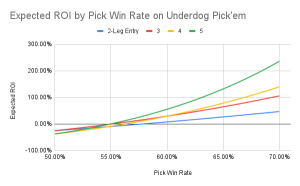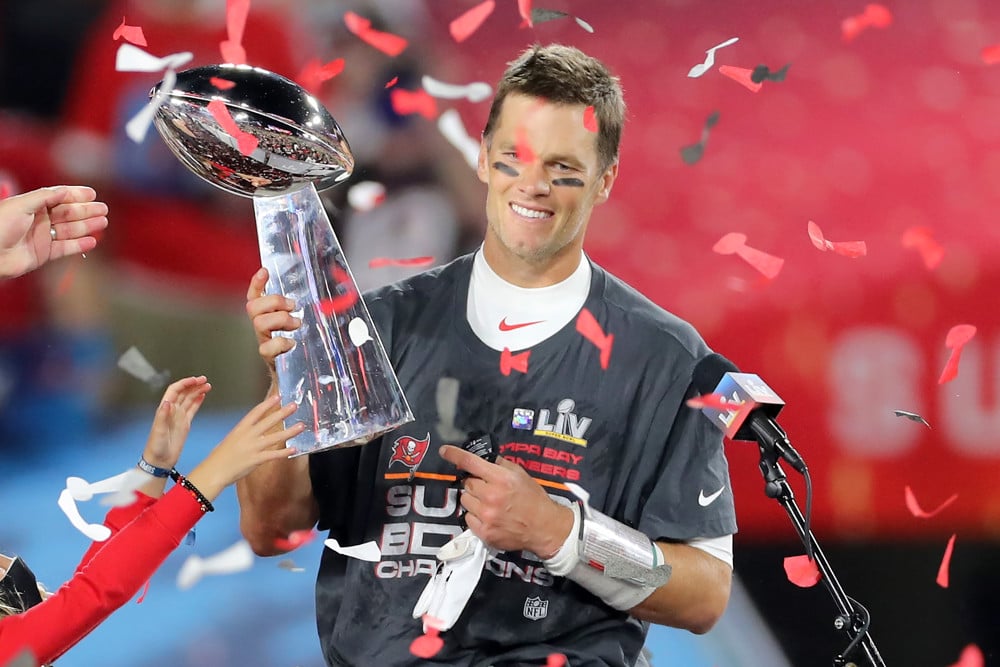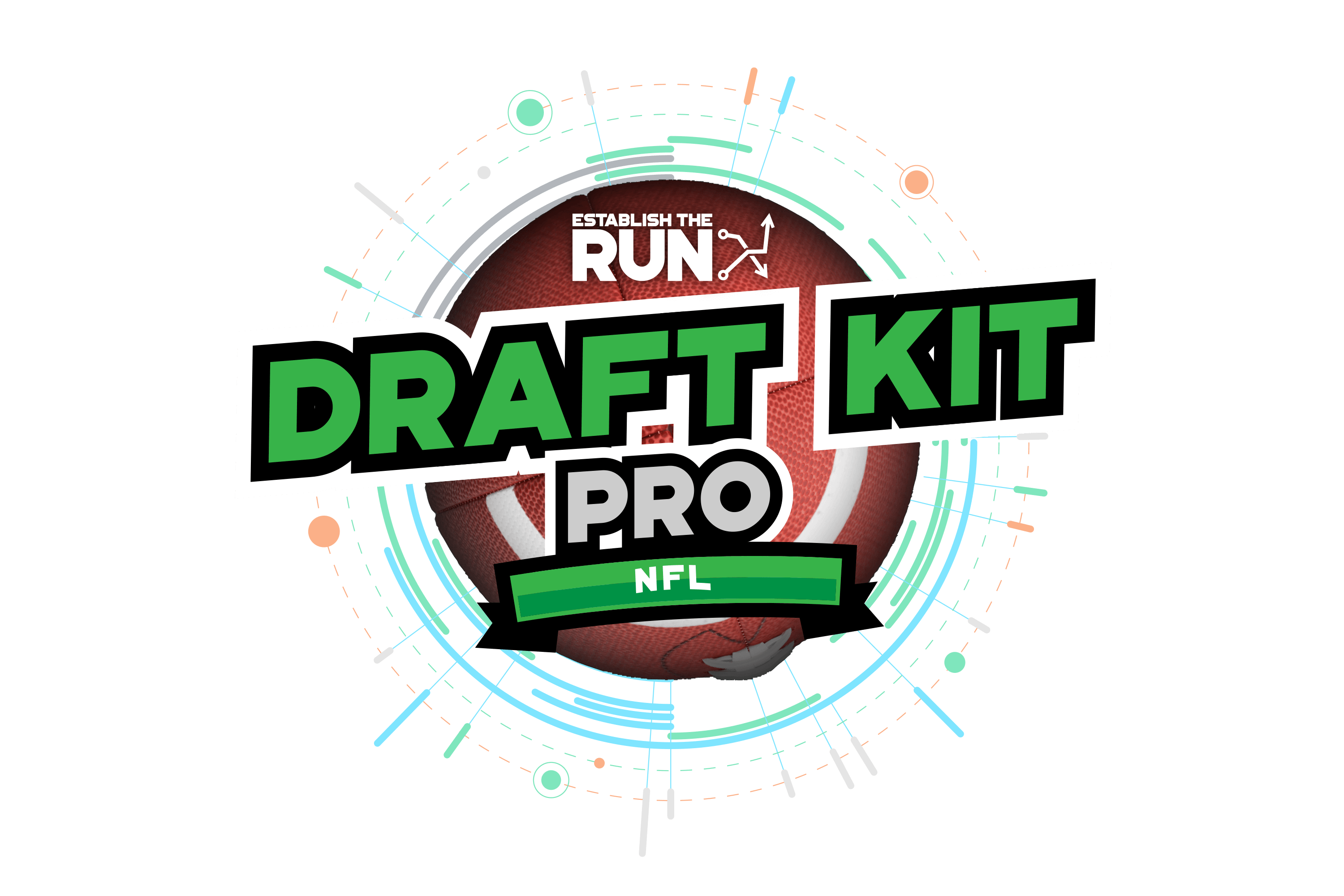Our friends at Underdog Fantasy don’t just offer Best Ball. They also offer “Pick’em” fantasy contests which require players to make picks on two or more fantasy statistics (i.e., passing yards, receiving yards, points, rebounds, etc.) to build an entry. With a thorough understanding of the math and strategy of these contests, it is quite possible for a smart player to find an edge and win.
HOW UNDERDOG PICK’EM WORKS
Players build an entry with multiple picks and when you win, you are rewarded based on how many picks your entry has. The payouts are as follows:
- If you hit a two-pick entry, you profit two times your entry fee (the equivalent of +200)
- Three-pick entry and you profit five times (+500)
- Four-pick entry and you profit nine times (+900)
- Five-pick entry and you profit 19 times (+1900)
Notes on rules:
1. Underdog mandates that each entry must contain players from at least two different teams.
2. If one of your picks pushes, it is simply removed from your entry and your parlay goes down a leg (i.e., a four-pick entry with a push would become a three-pick entry). That is, of course, unless a push leaves you with only players from one team, in which case your entry is refunded.
3. You are allowed to include picks from different sports in the same entry.
HOW MANY PICKS SHOULD WE INCLUDE IN OUR ENTRY?
The first question we have to answer is how many picks to include in each entry. Let’s take a look at the pick win percentage (and implied site fees) and entry win rate you need over the long term to break even for each type of entry if every pick was independent:
| Number of Picks | Pick Win Rate Needed to Break Even | Implied Site Fees | Entry Win Rate Needed to Break Even |
|---|---|---|---|
| 2 | 57.7% | -136 | 33.3% |
| 3 | 55.0% | -122 | 16.7% |
| 4 | 56.2% | -128 | 10.0% |
| 5 | 54.9% | -122 | 5.0% |
Right off the bat, you can see that we want to mostly focus on entries with either three or five picks. That’s because they require the lowest individual pick win rate needed to break even. They have the lowest implied site fees.
Five-pick entries will bring extreme variance — you can lose 95.0% of the time and still break even! — but they have the lowest breakeven pick win percentage. Three-pick entries are a little safer at the expense of a tenth of a percent of breakeven hit rate. Which is preferable?
The short answer: Five picks are likely better for winning players, but there’s no simple one-size-fits-all solution. It depends on a variety of factors, including your expected hit rate, the sport you’re playing, the volume you’re playing, and — the only qualitative factor we’ll mention throughout this article — your ability to handle losses without tilting and trust your process over the long term.
If you have an edge and your goal is to maximize ROI, five picks is the clear answer. While the gap between three and five picks is negligible at a breakeven rate, the difference is amplified as your pick win rate increases. That makes sense if you think about it: You profit five times your risk for a three-pick entry and 19 times for a five-picker. Mathematically, that’s the equivalent of adding two extra -105 picks (51.2% breakeven) to your entry. If you know you have an edge — meaning you can hit at least the breakeven rate of ~55% — that’s a no-brainer from an ROI standpoint. If that didn’t make sense, the graph below illustrates how your long-term ROI increases with more picks if you’re hitting at a high rate:

Entries with two or three picks are the safest options, minimizing your losses if you aren’t hitting at a breakeven rate, but larger parlays become optimal ROI-wise if you can win more of your picks. That’s easier said than done — and good luck hitting 70% over the long term — but it’s still critical background knowledge for anyone taking Underdog pick’em seriously.
For most players with a longtime horizon, five-pick entries are optimal. However, there is an argument to be made for smaller entries for higher-stakes players. Underdog currently allows a maximum entry of $500. The max risk on one player at the same time is $750 (not per individual leg but rather on the player overall, so you cannot bet Luka Doncic points for $750 and Doncic rebounds for $750). To mitigate variance and potentially increase how much money you are entering, you can spread that among multiple entries.
Say you’re a high-stakes player who sees value in six spots today. If you’re only doing five-pick entries, you might do one or two $500 entries (the second one would either have to have overlap in 4/5 spots, or you’d have to add other picks that you don’t see as much value in. Which, considering that the average juice to increase from three picks to five picks is -105, is actually completely reasonable).
If you hit 56% and stick with five-pick entries, you are risking $500 or $1,000 on the day with an expected ROI of 10.1%. That’s one option. Another option is to make four three-pick entries with no overlap (and, as such, significantly less variance, although that should negate itself in the long run). Your expected ROI is just 5.4%, but you can theoretically risk $1,500 if you want to.
That’s an overly specific example — maybe in the first scenario you make one $500 five-pick entry and use your remaining $250 per player in smaller entries with your sixth value spot — but the overarching point is that we want to maximize profit, not ROI. In the majority of cases, that’s going to mainly involve five-pick entries, but there is slightly more nuance to it than meets the eye.
The other variable is your own personal ability to withstand losing streaks without tilting and/or doubting your process. With a breakeven entry win rate of 5.0% on five-pick entries, you’re going to lose a lot more than you win. Even if you hit at 60% on individual picks — which is really good — you’re only winning 7.8% of the time. If you’re the type of person who tilts hard during losing streaks, it’s likely wiser from a financial and mental perspective to stick to three-leg parlays.
We’ve mostly talked about three- and five-pick entries. Four-pick entries are also viable (and becomes +EV compared to three if you’re hitting at least 60%), but you might as well do five if you’re choosing to embrace the math and accept the variance because the expected ROI is so much higher.
The reason I bring this up is to point out that we have not discussed two-pick entries. The reason is simple: They are bad value. With -136 implied site fees and the lowest expected ROI for any winning player, there is no reason to make two-pick entries. If you aren’t sure whether you’re a winning player and want to keep it safe, go with three-pick entries. Three picks boast a superior ROI to two at every pick win rate above 50%, and there’s no reason you should expect to get fewer than half your picks right in the long run.
This also means we generally want to avoid being forced into a two-pick entry. If you have a three-pick entry with one prop that could push, it may be wise to find another value spot so that you don’t end up playing the two non-pushable picks at -136 instead of the -122 you were trying to pick.
That was a lot of words about how many picks to include in your Underdog pick’em entry — not exactly the most enthralling topic in the world. Let’s quickly sum up what we learned:
- If you’re a winning player, five-pick entries will maximize your ROI over the long run; although there will be extreme variance with a 5.0% breakeven entry win rate.
- Three-pick entries are a strong option for those who want to play it safe. It has the second-lowest breakeven rate (behind five) and has a better expected ROI than four picks through the 60% mark.
- Two picks are easily the least viable option but likely one of the most popular on account of its safety. Don’t fall into the trap — if you’re doing a two-pick entry, find something else to make it at least three picks. It’s the same EV to literally flip a coin and pick a random play on the board to make it a three-pick entry rather than sticking with just two.
TIPS ON IDENTIFYING WINNING PICKS
Now that we know how many picks to include in our entries and the factors that impact that decision, let’s quickly run through some tips on how to identify winning picks. At the end of the day, you can follow the math from the previous section all you want, but none of that matters if you’re not winning your individual picks at an above-breakeven rate.
- You need to include picks from at least two different teams, but correlating them is still possible. For example, Purdue had two elite centers last year in Zach Edey and Trevion Williams, but they were never on the floor at the same time. As a result, one of them getting in foul trouble would lead to increased minutes for the other guy. They also switched off who was on the floor in crunch time, presumably with their performance earlier in the game as a premier factor. That means you could correlate two picks in your entry by taking an Edey over and a Williams under (or vice versa) because one outcome would make the other more likely. You’d still need another pick from a different team, but the idea remains that you should be looking for hidden correlations when making your entries.
- You can also sometimes capitalize on breaking news, especially in smaller sports. If Justin Jefferson is ruled out, Adam Thielen‘s lines would likely be pulled immediately because there are so many eyes on the NFL. However, if a college basketball player is declared inactive right before the game, there might be a chance for you to take the over on players who benefit from the news.
- Sportsbooks have the luxury of charging juice to play props for which one outcome is more likely. For example, maybe Trevor Lawrence‘s interceptions prop is juiced to the over. Underdog doesn’t have that option, as they just ask you to pick the over or the under. Comparing Underdog lines to the books is an easy way to mine value by finding stuff that is -140 on the books but the equivalent of -122 in pick’em. This is more viable for sports like NFL and NBA where there are a lot of eyes on the prop market pushing the prop into a sharp-ish spot through price discovery. It’s also more viable closer to game time once the market has matured a little bit.
- Sports like college basketball and WNBA don’t have a robust props market, but those sports also present the most opportunity for players with high domain knowledge. In short, it’s a lot of work to play those sports correctly on Underdog, but the reward is also higher because they are often originating the lines or copying them from a single place rather than mimicking the market consensus.



